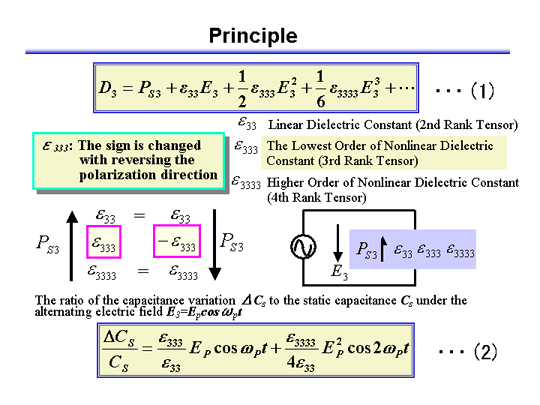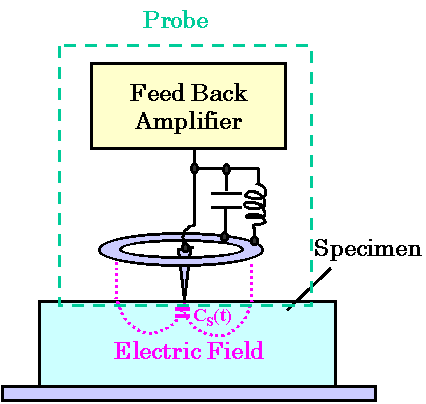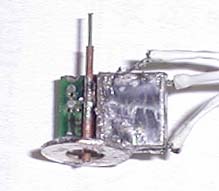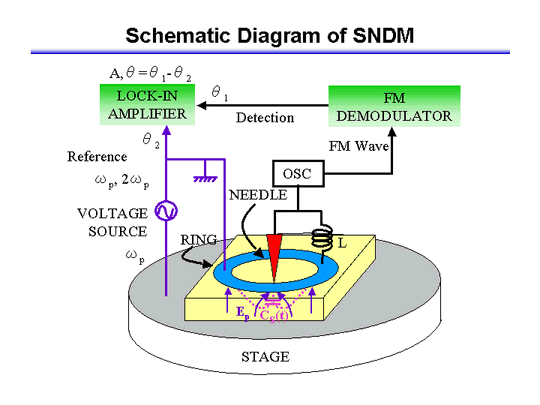
SNDM is one of the scanning probe microscopes. Using SNDM, the nonlinear dielectric constant, which is required for the polarization information, can be detected.
The sign of the nonlinear dielectric constants depends on the polarization directions. On the contrary, the linear dielectric constant's sign is always plus, then it is not useful for its purpose.
The nonlinear dielectric constant is the coefficient which shows the change of the dielectric constant under the electric field.
Thus, for measuring the nonlinear dielectric constant, SNDM detects the change (increase or decrease) of the dielectric constant under the electric field.
For the simple consideration, let's use the parallel-plate capacitor model in the following figure and assume the uniform electric field E3 parallel in Z-direction. When we apply the electric field Epcosωp, the variation capacitance ratio to the original one is given by the equation (2).
Therefore, we can measure the nonlinear dielectric constant ε333 by detecting the capacitance deviation at angle frequency of ωp.(If we detect the signal at frequency of 2ωp, we can obtain the signal corresponding to the higher order nonlinear dielectric constant ε3333.
The value of the nonlinear dielectric constant is a minute (For example, nonlinear permittivety ε333 is about 10-6 times of the linear one ε33).

It is possible to measure this capacitance variation using inductance and capacitance (LC) resonater circuit.
The capacitance depends on the dielectric constant of the specimen. The resonance frequency f of the LC resonance circuit is given by

Thus, we can detect the capacitance variation as the frequency shift from the original the LC oscillator's one because of the specimen's capacitance change.
It is easy to measure the resonance frequency with frequency conter precisely.
Moreover, by using the mixer, we can obtain the frequency shift with high resolution. (It is easy to understand, if we consider the situation that the broadcasting satellite (BS) signal (10GHz) contains the audio signal (1kHz).)
This original technology was developed by Professor Cho as a dynamic measuring method of a nonlinear dielectric constant in 1992.
When we determine the dielectric constant (average value) accuracy, a parallel-plate capacitor using target ferroelectric material is useed.
However, in case of the 2-dimensional measurement, we use the needle (probe) composing the capacitor with ferroelectric material.
Thus, probe quality is very important for the 2-dimensional measurement with high resolution.

This probe contains the ring connected to the ground, the electro-polished metal needle, the inductance L and the capacitance C. All these parts connect to the feed back amplifier.
The LC resonator is composed of the capacitance just under the needle CS, the floating capacitance C and the inductance L, and this LC resonator is connected to the oscillator tuned to the resonance frequency of the resonator.
When the capacitance between the needle and the ring (electrode) changes with the dielectric constant of specimen, the resonance frequency changes with this capacitance. Thus, SNDM detects this capacitance change as the resonance frequency deviation.
In this connection, this special probe can detect the capacitance deviation with 10-22F resolution.

This picture shows the special probe of SNDM. The radius of the ring is about 7mm. The oscillator is in the silver box.
We can obtain the signal corresponding to the linear dielectric constant by detecting the resonance frequency. And in case of the nonlinear dielectric constant measurement, we use the SNDM system shown as follows.

The capacitance just under the needle CS(t) is changed with the applied electric field Ep because of the nonlinear dielectric responce. SNDM detects this capacitance variation as the resonance frequency deviation.
In concrete terms, we detect this frequency modulaterd (FM) signal which is produced by the oscillator using FM demodulator and lock-in amplifiler. The signal corresponding to the lowest order nonlinear dielectric constant is obtaned by setting the reference signal of the lock-in amplifier at the frequency of the applied electric field Ep.